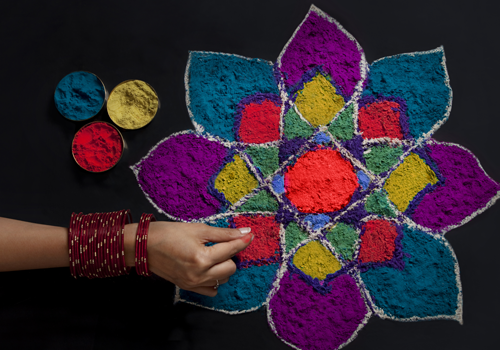Rangoli is a Hindi word derived from 'rang' meaning colour and 'aavalli' meaning row or coloured creepers. The origin of rangoli is traced back to a legend in the Chitralakshana, the earliest Indian treatise on painting. When the son of a King's high priest died, the king and his entire kingdom was mourning and in deep sorrow. The king prayed every day to Lord Brahma, the Lord of the universe, who, moved by his prayers, asked him to paint the portrait of the boy on the floor so that he could breathe life into him again. It is believed that the first painting was made in this way! It is also how flowers and rice flour were transformed into offerings to God in the form of floor paintings.

According to another legend, one day, God, in one of his artistic spells, took out mango juice from one of the mango trees to use as paint and painted a figure of a beautiful woman. The painting is believed to have been so lovely that it put the heavenly maidens to shame. Rangoli became a popular form of women's self-portraiture after that. It is also believed that powder or sand is used for making rangoli designs as the combination of the colours and the design signifies the impermanence of life and 'maya'. Rangoli designs are made with no gaps in between, as it was believed that an incomplete rangoli can attract evil spirits!
Rangoli is commonly drawn in two ways - dry as well as wet. It does not require any devices such as a brush, ruler or a thread to draw it. Women and young girls make different rangoli designs during special occasions, festivals and wedding celebrations.
In ancient India, they were used to decorate the entrances of homes to welcome visitors. The design used to make rangoli includes idols, animals, lotus, geometrical patterns, swastika, conch shells, trident, footprints and much more. The main motive of creating rangoli designs is that it brings good luck.
Rangoli has also been mentioned in the two great epics. In the story of Ramayana, the people of Ayodhya painted rangoli designs to welcome back Lord Rama after fourteen years of migration in the forest. In Mahabharata, this form of art was used by the 'gopis' in their free time. In the ancient times, natural dyes like indigo and barks of trees were used to colour the rangoli designs. These days, synthetic dyes have replaced these natural dyes, although naturally derived dyes are widely available.